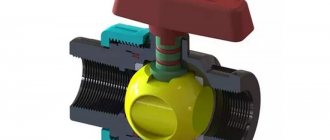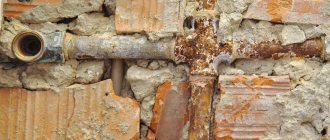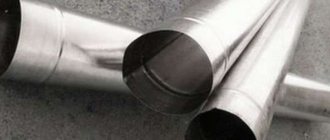Most delicious and appetizing dishes appear on tables using natural gas. Many owners would dream that this fuel would enter the kitchen almost unnoticeably, without disturbing the harmony and integrity of the style and design that they have been working on for a long time. Meanwhile, playing with gas pipelines and utilities can be fraught - gas is not a toy. In pursuit of style, you can lose everything, including your life. If the pipe is not located where you would like it, the gas pipe can be moved. But this should be done correctly and in accordance with the norms. We’ll look at how exactly in today’s article.
Reasons for transfer
Any work on moving or replacing pipes, especially those that require the use of welding equipment, must be performed by city gas specialists or any other authorized organizations. After receiving and processing an application from apartment residents, they always try to find out the reasons for the alterations.
Most often, moving a gas pipe in the kitchen is done for several reasons. This could be replacing old gas equipment. For example, instead of an old water heater, apartment owners want to install a new one, which requires more space. Also one of the popular reasons is a major renovation of the kitchen, moving the stove, changing the location of the gas meter.
Often, gas pipe relocation is carried out in new homes, where the basic position of important kitchen equipment defies any logic or simple explanation. For example, if in a kitchen with an area of 15 square meters the stove is installed near the window, the sink is located in the opposite corner, the hood is located in a completely different direction, above the entrance to the room. In this case, residents have to independently correct the mistakes of architects and designers. The stove is installed closer to the sink to make the cooking process more comfortable.
One of the most common reasons is the purchase of new kitchen furniture that has built-in equipment. This is, for example, an oven or hob. In this case, the gas pipe needs to be made a little shorter or longer. The size depends on where the equipment is planned to be installed.
To find out how best to carry out the transfer of a gas pipe, you should contact city design companies so that specialists can draw up a diagram. The thing is that in the case of standard city apartments, the reinstallation of risers, pipes and gas equipment from kitchens to living quarters is strictly prohibited. And even in the case when you need to combine a kitchen and a room, you also need to get permission.
Examination
Upon completion of all installation work, the entire system is checked for leaks and general performance.
Gas pipeline connection
In general, you need to check the following questions:
- The system is ready to function, that is, everything must be tightened, everything connected, and so on;
- No fuel leakage in all components and connections.
The test is carried out the old way - using a regular soap solution. It is applied with a brush to all connections. If bubbles appear after application, then we can say that there is a leak. This connection is made poorly and requires reworking.
Important! After completing all the work, the specialist who carried out the work is obliged to leave behind a report in which he indicates all the features of the work done.
It should also be noted that all changes are made to the premises passport. Contributions can be made only on the basis of the act, which was discussed a little higher.
How to obtain a work permit
To obtain a permit, you need to follow several steps. The first step is to find out the contacts of the gas service at your place of registration. Next, when the necessary information is available, you should consult with specialists and explain the situation to them. Afterwards, an application is drawn up - its standard form. Next, based on the application, a representative of the gas company will arrive at the apartment. He will conduct an inspection, get acquainted with your wishes, and answer your questions. Plans often change at this stage - the transfer may not meet safety requirements.
Next, the final pipe transfer scheme is approved and an estimate is drawn up. The entire package of documents is prepared by the relevant organization providing these services. The start of work will be possible only after the consent of the apartment owner.
If the transfer conditions are suitable, then all that remains is to pay for this service and agree with the craftsmen on the appropriate time to carry out the work.
The approval process may take up to five days. If the procedure is extended over a longer period, then only if the home owners have not found a compromise with representatives of the gas service. Even minor factors that violate the installation standards for gas equipment can cause failure of the gas pipe transfer.
What fines are provided for unauthorized installation, transfer, connection and replacement of a gas stove?
If you want to change the gas stove on your own, you must remember that improper installation and connection of the stove pose a danger to the life and health of people around you.
Do not neglect the life and health of your family and other people. For creating a dangerous situation, you may be sentenced to imprisonment or a large fine.
To avoid adverse consequences, it is very important to thoroughly study the issue of what fines are entailed by independent installation, connection, transfer and replacement of gas appliances. We will also consider in detail what specific criteria are used to identify an illegal connection to a gas pipeline.
What is an illegal connection?
Due to multifunctional gas distribution stations, internal gas pipelines and mains, gas is supplied to premises for various purposes.
Self-connection is an unauthorized action aimed at connecting devices to structures that distribute gas.
Gas appliances come in the following types:
- Convectors;
- Columns;
- Gas stoves;
- Water heating boilers;
- Other.
Indoor gas devices include taps and control lines. At the legislative level, it is prohibited to consume gas without accounting and to install pipes illegally.
Each device powered by gas is taken into account and reflected in the gas supply agreement. Based on the results of equipment installation, the subscriber is given a certificate of putting the devices into operation. If there is no corresponding document for at least one device, this is perceived by the controlling organization as an unauthorized connection and installation.
According to the Legislation of the Russian Federation, only authorized persons, who, as a rule, are employees of the gas supply service, have the right to carry out activities in relation to gas equipment.
Employees of a company that, on the basis of a contract, carries out maintenance of gas appliances, have the right to request supporting documents for the technical serviceability of the equipment being inspected. Regardless of whether the visit to the gas company workers was planned or not, an act is created based on the results of the inspection.
The act takes into account the following mandatory data:
- Date of inspection;
- Personal information of the employee who carried out the inspection, as well as the subscriber;
- Characteristics and analysis of found faults (if any);
- The address where the inspection was carried out;
- Condition and description of gas appliances.
Employees must immediately notify their direct supervisors of any identified case of unauthorized installation and connection.
A report on unauthorized manipulations on the part of the subscriber is drawn up by the emergency service. A subscriber who has disregarded the legislation of the Russian Federation is required to sign this document.
Otherwise, the controlling agency will not be able to refer the case for further consideration by the court.
What responsibility does self-assembly and connection entail?
Activities related to self-installation of gas appliances, connection to a gas pipeline, deformation of the pipeline and other unlawful manipulations are punishable. A person who commits an offense may be subject to a fine, as well as administrative or criminal punishment.
Let's consider this issue in more detail.
Types of punishment provided for breaking the law
Administrative and criminal liability for unauthorized connection of gas appliances is provided for in Article 7.19 of the Code of Administrative Offenses of the Russian Federation.
If gas was released into the building without authorization (and there was no permission to connect), the subscriber will be subject to a fine of 10-15 thousand rubles. Persons engaged in economic activities will have to pay 100 - 200 thousand rubles. The specific amount will be determined in court.
In accordance with Articles 109 and 158 of the Criminal Code of the Russian Federation, due to unauthorized accession, criminal penalties may be provided in some situations.
Similar measures are applied to those persons in whose activities the following factors can be traced:
- Disruption of in-house devices that are connected to the gas supply;
- Large-scale theft of gas;
- Creating a dangerous situation for the lives of surrounding people.
The subscriber must present: permitting documentation for the equipment, receipts confirming payment for gas use, a maintenance agreement concluded with the gas service.
How to calculate additional payment for damage?
In addition to penalties, the subscriber must pay all expenses incurred by the gas supply company. The amount of damage depends on the time period: the additional payment begins to be calculated from the date of the last inspection, but no more than 6 months until the violation is eliminated.
Let's study an example:
- Based on the results of a routine inspection on February 1, gas service workers did not find any violations.
- On March 31, an unscheduled inspection was carried out, as a result of which unauthorized connection of devices was revealed.
- The violation was corrected on April 14.
The additional payment will be calculated for 73 days. The violator must eliminate all shortcomings as soon as possible, since the elimination is calculated from the date of confirmation by the regulatory agency.
In further calculations, the power of gas appliances should be taken into account.
Let's consider an option adjacent to the stove, a gas water heater - a Bosh brand water heater, model Therm 4000 O WR13. For him, the amount of accrual will be as follows:
- Based on the technical data sheet, the volume of gas required reaches 2.8 m3/h.
- Provided that the device operates around the clock, the column consumes 4905.6 m3 within 73 days.
- For example, the tariff is 8.2 rubles per 1m3.
Based on the results of the calculations, we conclude that the additional payment is equal to 40,225.9 rubles .
Penalties for illegal installation of a gas stove
There is a very fine line between legal and illegal actions regarding the installation of gas devices. Permitted independent manipulations include installing a column.
This process involves placing the housing on the wall surface and connecting the device to the water supply.
Further connection of the gas stove to the main line can only be made by an authorized person who is a representative of the gas supply service.
There are basic requirements for the premises:
- The total area should be from 8 sq.m;
- Ceiling height – from 2 m;
- Proper ventilation.
Before installing water heating equipment, it is necessary to decide on the location and prepare documents.
There are a number of specific rules on the basis of which the column is connected to the gas pipeline:
- The fixation area must have a non-flammable composition (for example, tiles or asbestos panel);
- The distance between the column and other objects must be more than 10 cm;
- Optimal dimensions when connecting to a chimney: slope angle should be 30, length - at least 30 cm, diameter - from 12 cm.
- Water pressure – from 0.1 Atm.
When using a flexible hose, water is supplied.
The subscriber must collect the following documentation:
- Application for installation work;
- Permission from the gas supply service for installation in accordance with the developed project;
- Project;
- A document confirming the serviceability of the chimney and ventilation;
- Technical passport of the column and all documentation for it.
In case of first installation, the subscriber must request permission from the city administration for redevelopment. Based on the results of the activities carried out, the project is sent to the technical bureau. inventory.
Installation of a geyser consists of the following steps:
- The surface of the wall is marked;
- Next, holes are made;
- The speaker body is hung;
- A water filter is installed;
- A tee cuts into the pipe;
- One part of the pipe is combined with the chimney, and the second with the pipe.
Gas connection is carried out only by a gas supply service employee. The approximate cost of installation reaches 2,500 rubles.
Illegal replacement of gas equipment (stoves, water heaters)
As was revealed earlier, unauthorized manipulations with gas have adverse consequences, which are presented in the form of punishment. Let's study in more detail how such unauthorized actions can turn out.
Results of self-replacement of equipment, using the example of a gas stove
Based on Article 7.19 of the Code of Administrative Offenses of the Russian Federation, individuals are required to pay 10-15 thousand rubles (penalty). Employees of public services will have to pay a much larger amount - from 30 to 90 thousand rubles.
For property damage caused, a fine in the amount of up to 80 thousand rubles . Other types of punishment are possible, for example, arrest for up to 1 year .
What are the adverse consequences of unauthorized movement of a gas appliance (stove or water heater)?
Despite the fact that installing another column is not a labor-intensive process, independent work of this nature is regarded as unauthorized.
The size of the fine directly depends on the assessment of the offense. Thus, according to Article 7.19 of the Code of Administrative Offenses of the Russian Federation, punishment is provided in the form of a sanction of 10-15 thousand rubles .
If an unlawful action created a dangerous situation for the health of another person or led to his death (for example, a water heater or stove exploded and people were injured), an arrest for up to 6 years .
Before you begin, you need to remember the following:
- Self-transfer may cause gas shutdown;
- Before installing equipment at a new location, you should submit an application for amendments to technical documents;
- Movement can be carried out if the distance from the original position is no more than 1.5 m;
- Installation of a water heater is not permitted on load-bearing walls.
Neglecting the rules for working with a gas stove
If during the next inspection some problems are found, the gas service may stop the supply of gas. The subscriber must reimburse all gas service costs incurred during the shutdown process. In this situation, there is no penalty.
An individual is obliged to provide free access to gas taps, hoses and pipes. They should not be crowded with furniture. Users of dispensers must strictly follow all rules for using gas equipment.
Neglecting the rules for working with a gas stove
In the absence of a maintenance agreement with a regulatory organization, a fine of 1-2 thousand rubles .
The organization diagnoses the gas device, and if the dispenser has expired, it stops the fuel supply. Based on the results of the inspection, an order is issued to further change the equipment.
Main conclusions
Connecting, installing or changing gas devices requires a special approach. By following all the rules and following the standards, you are able to ensure the safety and comfort of your home. In this case, the geyser will serve you for a long time without any problems.
If you want to know about the consequences of unauthorized connection of gas appliances, you can contact our employees. Specialists and site guests will try to help you and find answers to all your questions.
If you have any useful information on this topic, share it in your reviews!
Source: //rushmaster.ru/kakie-shtrafy-predusmotreny-za-samovolnuju-ustanovku-perenos-podkljuchenie-i-zamenu-gazovoj-plity/
SNiP requirements
In order for the approval process not to take much time and to be successful, it is better to know in advance all the basic provisions about the design of gas systems in residential premises. The document numbered SNiP 2.04.08-87 is well suited for this.
According to it, the kitchen must be equipped with natural supply and exhaust ventilation. There should be a window with vents, as well as a ventilation duct with good draft. If the walls in the kitchen, as well as the ceiling, are decorated with flammable materials, it is better to apply plaster or metal sheets.
The pipe is one of the links in the transportation system that supplies gas to the consumer - stove, oven, water heater. Therefore, how the equipment is placed is no less important than the routing of the pipes. This needs to be remembered.
It is important to know that during the process of moving the gas pipe in the apartment, you cannot remove the shut-off valve. This element is mandatory in all gas systems. When making any changes to the structure, it is important to ensure that the crane is nearby. If the faucet is hidden under the countertop, then access to it should be through a cabinet without a wall at the back.
Technology and stages of operations performed
Work on moving gas supply pipelines does not take much time and labor resources. Dismantling and installation of one pipe takes one hour of working time for a team of welders and installers consisting of two people. Moving a gas pipe in the kitchen by one worker is strictly prohibited.
Preparatory activities
Owners of an apartment or private house are not recommended to change anything in their gas system, not even flexible hoses. The transfer, extension, and cutting of pipes has the right to be carried out exclusively by a representative of the gas service with the appropriate permit. However, it would be useful for people using gas equipment to know some of the provisions and sequence of actions when carrying out gas pipes.
Most often, a specific moving team consists of two people. Both specialists are trained in all operations, have a certificate for working with gas equipment, and professionally carry out welding and metal cutting. The craftsmen begin work on site within one calendar week after agreeing on the technical documentation for moving pipelines.
At the time of the team’s visit, the points for dismantling, extending, and installing additional gas equipment are already known. Gas water heaters, stoves, ovens, and heating elements are subject to modification. The craftsmen are perfectly familiar with the rules for performing installation operations. According to regulations, it is not recommended to cut off valves blocking the gas supply. They are mandatory components of the gas transportation system.
Preparatory activities before moving the gas pipe
In addition, according to the rules for using gas as a fuel, when moving the points of the pipeline, as well as changing the gas valve, a specialist must install it in such a way that the valve is located in an area of direct access for the user. The valve installed under the countertop requires easy access through a cabinet door with the back wall removed. Sometimes access is through a piece of countertop that opens.
Taking this opportunity, the apartment owner can install a gas control meter. You can also replace any outdated kitchen equipment. The team that is moving the gas pipe to another location should be warned in advance about these operations. When connecting ovens, stoves, speakers, the owner of the apartment is obliged to buy a bellows hose in advance, selected according to the size.
Invited workers purchase metal pipelines themselves. The cost of pipelines is included in the total estimate of services, materials and equipment. The owner needs to clear the kitchen space of furniture and bulky items. This way, specialists will carry out the entire complex of installation on your gas pipeline faster and with better quality. Things that cannot be taken out must be covered with non-flammable dense materials.
Pipeline dismantling
Most likely, when moving, you will need to cut out a section of the old pipeline and extend it onto a new one, only in the opposite direction. In this case, a specialist, using special devices, cuts out unnecessary elements. Here, the qualifications of the worker who has permission to move gas pipes plays a huge role.
Electric welders, gas cutters, mechanics are trained in special courses, where they are certified by professional gas equipment workers. After passing serious exams, they are given a special document. Having dismantled the branch leading from the riser to the device, the master leaves a section of the pipeline. A liquefied gas shut-off valve is installed on it.
This section of horizontal pipe must not be changed or removed under any circumstances! There can only be one situation - an accident with damage to the pipeline. If it is impossible to do without a complete replacement, then it is permitted. Often in practice, residents of the upper floors of apartment buildings ask to cut off a long piece of pipeline.
This element rises from the lowest point of the apartment to the highest point to a height of 1.8 m, then bends at an angle of 180°. It is prohibited to shorten such a pipeline by installing a valve on the remaining piece. But there is a solution for this situation - it is necessary to weld the pipeline and place the valve at a height of 75 cm from the floor under the countertop.
Preparation
Most often, the team comes to the client within a week after successful approval of the relocation of the gas pipe in the apartment has taken place. By this point, it is already known exactly which sections need to be lengthened, reduced or dismantled, and where additional equipment will be installed.
Kitchen equipment and appliances are purchased entirely at the expense of the homeowner. It is better to find out in advance from the craftsmen what else may be needed for the transfer work. If you need to connect a stove or oven, you need to purchase a bellows hose. The craftsmen will bring the metal pipe with them.
To avoid any delays in work, it is better to remove excess furniture or any other objects from the area that may interfere.
The nuances of using bellows hoses
Before moving or changing the design of a gas pipe, it is necessary to consider the possibility of installing a flexible bellows hose. The type of such liner is indicated in the technical specifications. Official designation: fitting-fitting, nut-nut, fitting-nut. In past years, rubber-fabric and rubber samples were produced for these purposes. As technology improved, it became clear that bellows are stronger than all materials that are hopelessly outdated.
The bellows is a composite or metal corrugation with unique technological characteristics.
For a long period the product retains 100% elasticity and tightness. Even with active mechanical stress, the structure of the shell is not deformed. The installation of bellows is also carried out by gas service specialists in your city.
Invited specialist:
- connects boilers;
- hangs speakers;
- installs ovens and gas stoves.
A gas service professional performs all work efficiently, in compliance with the rules of the PUE. If necessary, the master uses FUM tape, seals, and adapters. Typically, users ask a specialist to hide gas pipes behind furniture or decorative panels. There are many different camouflage options that will make gas wiring invisible.
Dismantling
When moving gas pipes in a private house or apartment, you need to cut out a piece from the old pipe and weld a new one, but in a different direction. To do this, old elements are removed using a special tool. When restoring or repairing the branch that comes from the riser, you should leave the area where the new tap will be. This piece of pipe cannot be dismantled and replaced.
Sometimes people living on the top floors ask the craftsmen to dismantle a large piece of pipe that rises from floor to ceiling, and is also bent down 180 degrees. This is strictly prohibited. The solution is to change the design so that the tap can be hidden under the countertop.
What needs to be done before specialists begin the transfer?
Gas supply system diagram.
- First, collect all the required papers. Since the companies involved in servicing gas pipelines are, as a rule, state-owned, they need documentary evidence of both ownership of the site and registration of the gas pipe passing through the site.
- Secondly, you need to decide on the final destination of the gas pipeline. If this is an underground gas supply system, heavy construction equipment will be required to reach the pipeline.
- Thirdly, you need to choose the right time - it is unlikely that it will be convenient to move the pipe in winter, in cold climates.
- Fourthly, the most difficult thing is the human factor. As a rule, a gas pipeline does not come to a site from nowhere and does not go anywhere. Neighboring private houses are also supplied with gas from a passing gas pipeline, and this does not happen painlessly everywhere. Very often controversial issues arise, especially if on one of the sites there is a so-called easement - a section of a gas pipeline to which nearby houses can be connected.
Basic transfer rules
When changing the direction of the gas pipeline in an apartment, certain rules must be taken into account. The gas distribution in the apartment is open. Any elements perform only a camouflage role and should not be securely fastened. Pipelines are not laid through ventilation ducts, doors and windows. This is strictly prohibited. Metal pipes are used. The method of attaching the hoses to the pipe is only rigid. Transitions through partitions between walls must be equipped with special sleeves.
Welding work
SNiP standards provide: no matter what changes in the position of gas pipelines, they must be carried out only by welding. Any detachable connections between two pipe sections are prohibited. Threaded connections are only suitable for gas meters, shut-off valves and household appliances. When working with welding, the master is obliged to use only serviceable devices, tools, and fixtures.
Personal protective equipment is also required:
- special welding gloves;
- mask, shield or goggles;
- work clothes made of thick, non-flammable fabric.
When welding, you must use a mask.
Sometimes there are places on the walls, ceiling, and equipment that are burned by welding. Such phenomena have an unpresentable appearance, spoiling the design of the room, requiring protection against corrosion. Having completed all operations, the craftsmen must treat them with waterproof metal paint. The color of the dye is selected to match the main coloring of the walls.
Transfer of pipes in sections
Among the reasons for the need to carry out this work is the unfortunate location, which does not allow building a house or any other buildings on the site. There is a law that restricts construction with a foundation when work is carried out close to a gas pipe. Also, another unpleasant reason for moving is the unfortunate location of the pipe even before purchasing the site. But all this can be fixed. How?
In this case, all operations are carried out in the same way as in the case of apartments. The first step is to call an authorized person who will inspect everything. Next, they collect a package of necessary documents. Then the site will be visited by craftsmen who will carry out the transfer of the gas pipe on the site. There are some peculiarities in this process. They are indicated in the relevant SNiPs.
Among the main requirements are the following: the distance between the foundation of the building and the gas pipeline must be more than two meters. Pipes in which the pressure is average should be at a distance of four meters from the house. High pressure systems - at a distance of at least seven meters. Also, according to building regulations, the gas pipe must be placed in such a way that it is removed from the door or window opening at a distance of at least five meters. From the roof - at a distance of two meters.
Specialists know all these standards and will be able to professionally cope with this task without any risk. Changing the position of the pipes yourself is very dangerous and should not be done.
Unauthorized transfer of gas equipment threatens large financial losses
Blue fuel has long and organically entered our everyday life.
A stove and oven, a heating boiler and a gas convector, a water heater make our life comfortable. Sometimes we decide to replace some of our gas equipment with a newer, modern one. But unauthorized transfer of gas equipment has dangerous consequences for the life and health of all residents of the house.
As well as large financial losses in the form of fines and even criminal liability.
Let's look at what liability is provided for the unauthorized transfer of gas appliances by current laws. And what are the consequences of connecting to gas supply networks if not agreed upon with the gas supply organization?
Responsibility for unauthorized connection
To ensure the safe operation of gas equipment, Decree of the Government of the Russian Federation No. 410 dated May 14, 2013, updated as of January 1, 2021, was issued. Providing measures to ensure the safe use of gas equipment in residential buildings and apartments.
The same document determines that only authorized organizations are given the right to manipulate gas appliances. Gas service workers have the right to check the compliance of installed gas appliances with the list in the gas supply contract.
With whom the maintenance contract is concluded.
If the inspection reveals a device not specified in the contract, this is considered an unauthorized connection. This entails a fine, an obligation to compensate for losses, administrative and even criminal liability.
Amount of penalties
For starting gas independently, the homeowner is subject to a fine of 10 to 15 thousand rubles. Provided that the gas networks are connected in a technically sound manner. But there is no permission to connect. If this action is committed by a business entity, then penalties are determined by the court. Their possible size is from one hundred to two hundred thousand.
But if the unauthorized connection caused serious consequences, then criminal liability is also provided. List of consequences classified as serious:
- if as a result of an unauthorized connection there was a leak or theft of “blue fuel” in a significant amount;
- if the network, gas pipeline and related technological facilities are damaged or rendered unusable;
- there was a threat to the life and health of residents and gas service workers.
If any of the listed consequences occurs, the punishment may be imprisonment. Valid for up to 2 years.
In addition to the above liability, the person who committed the violation is obliged to compensate for the damage. Which was caused to the gas supply organization by unlawful actions.
What are the consequences of unauthorized transfer or installation of a gas water heater?
During the initial installation or transfer of a gas water heater, only employees of a specialized organization have the right to connect to the networks. But all the necessary papers must be completed:
- fire service report on working ventilation system and chimney;
- gas use project and connection permit;
- passport of the installed water heater;
- application from the homeowner to carry out gas installation work.
In case of unauthorized reinstallation or installation of the column, the violator faces a fine of 10-15 thousand rubles. But criminal liability is also possible. In accordance with Article 38 of Federal Law No. 69 “On Fire Safety”, it is possible to bring criminal liability under Art. 165 of the Criminal Code of the Russian Federation. The article provides:
- fine up to 80.0 thousand rubles;
- imprisonment for up to 2 years;
- corrections for the same period;
- arrest for up to a year.
Responsibility for moving the dispenser in case of property damage or death
If, as a result of moving the dispenser yourself, property was damaged or people were injured, then the liability is much more serious:
- the fine can be up to half a million rubles;
- arrest up to 6 years;
- forced labor up to 60 months.
Find out how to install a gas water heater without harming yourself or your neighbors, and not getting fined, from the video.
If you want to know about the requirements for the room in which gas equipment is installed, follow the link.
Gas appliances make our lives immeasurably more comfortable. But when installing and operating them, it is extremely important to comply with all rules and regulations. And then you won’t have to bear punishment and suffer from remorse.
Likes: 9 Dislikes: 0
I love learning something new, communicating with people. After all, every person is a whole world. I put my knowledge and thoughts into the articles. I hope that my articles will be useful. I would really like to know the readers’ opinions on the topics of publications. Perhaps someone has a different point of view.
Source: //allremont59.ru/inzhenerka/gas/samovolnyj-perenos-gazovogo-oborudovaniya-krupnye-poteri.html











